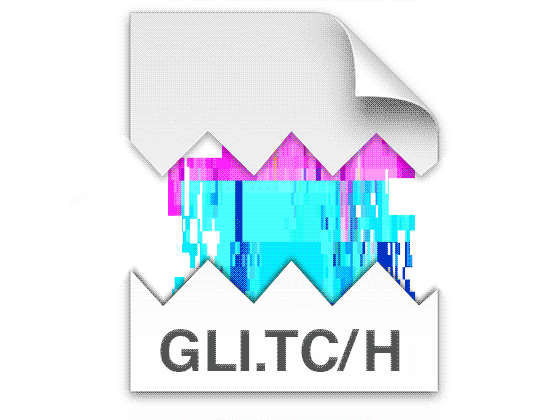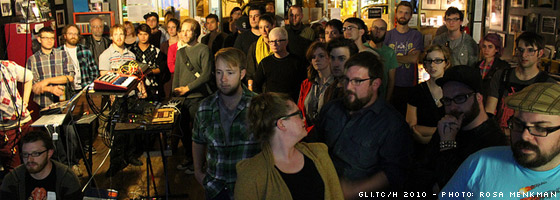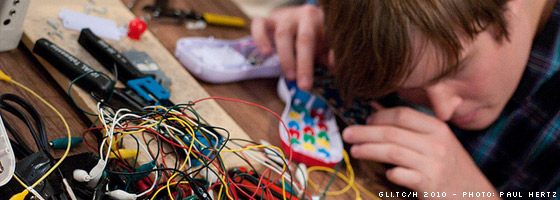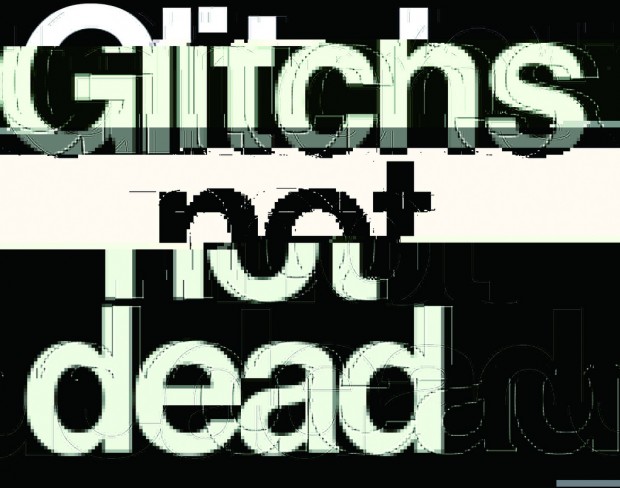GLI.TC/H 20111!?▐▐▐▀▀▀▀▀▀▄▄▀▀▌▌▌▐▐▐DIT▀▀▀▀▀Do▄it▄2gather▀▀▀▀

日本でもちょこちょこ耳にすることが増えたグリッチ。知らなかったのだが海外でもそういった流れがあるようだ。
GLI.TC/Hとは昨年にシカゴで5日間にわたって開催されたイベント。
グリッチをテーマに、コーディングワークショップ、スクリーニング、レクチャー、ディベートなどで構成されており、盛況だったようだ。
そして、今年はシカゴ、アムステルダム、バーミンガム(イギリス)にて11月に開催を予定、Kickstarterを通じて寄付を募っており、すでに目標金額は達成している。
イベントは無料で、パブリックにオープンな形態となっている。
Kickstarter GLI.TC/H
Kickstarterでは寄付額に応じて、もらえる特典が変わるのだが、これもなかなかグリッチっぽい。20GB GLITCH HARD-DRIVEとか、SURPRISE.ZIPとか。
気になる方はぜひ参加してみてほしい。(何もらえたか教えてく)
イベントはオンライン・オフラインでも同時的に進行し、ウェブサイトから作品を応募できたり、期間中には新たなAPIやダウンロードできる作品、オンラインゲームなどなど、実験的な構成になるとのこと。また今回はコミュニティを巻き込んでのキュレーターなども参加する予定で、GIFアニを売ったりしているアーティストKim Asendorf (fa-g.org & gifmarket.net) なども参加。
シカゴ発だったり、ウェブサイトもなかなかわかりにくいので、どういった感じなのかは掴め切れないがちょっと注目してみておきたい。
ちなみにUCNVさんがTシャツのデザインを提供していたりした。
以下はKickstarterでの寄付を募るコメントビデオ。



個人的メモ via Kickstarter
こういうのをちゃんと読んでいきたいんだけど、なかなかね。
肌感覚を感じたい欲求と難しさ。
Taken from the “From Artifact to Filter” notebook by Rosa Menkman, published by the Institute of Network Cultures.
To be released at GLI.TC/H 20111
█▌▌█▌█From Artifact to commodity: from databending to transcoding
Technicians and engineers (the ‘debuggers’) within the digital realm often occupy themselves with the task to control erratic reactions and behaviors of files, hardwares and softwares. Complex compression algorithms for mobile phones, DVDs and MP3s for instance, must minimize the amount of artifacts and make the medium as transparent as possible. In glitch art, these technicians and engineers (the “rebuggers”) engage themselves with an exactly opposite practice. They seek to prompt and amplify artifacts on purpose, and even write softwares or build machines with the sole intent to spawn more and new artifacts.
While the standardization of glitch-sound has been an ongoing development for more than 20 years, only in the decade a similar trend developed within the realm of visual glitch-generation-tools. But while every technology that is glitched leaves a specific aesthetic or fingerprint on its final result, more and more new glitch art is ‘modeled’ after original glitches within (older) media, developing what used to be a technology or information based phenomenon into a generic effect. With the help of these commodified effects any user can handle a broad range of data types and technologies in predetermined, often retro-nostalgic ways and create what can best be described as a caricature, or mimicry of what originally was an imperfect fingerprint
┐┐─▄──The emancipation of dissonance glitch.
Glitch artists often use the inherent movement of glitch, its procedural essence as part of their work. They exploit this instability to show a movement from not-understanding to an eye opener, or to play with the movement from shock to acceptation. There are however also artists who don’t incorporate this procedural quality at all. Glitch art is not always an art of the momentum; many works have already passed their tipping point, or will never pass one at all. As I have tried to show in the previous case-studies, glitch art moves in-between two extremes; the fragile momentum and the standardized commodity.
When a technical glitch is first found, the glitch artist will be one of the first to overcome it, by incorporating it into his practice. Once the informational or technical elements of the former glitch have been incorporated – a new form comes to existence, and the informational background of the new form often loses its importance over a new design aesthetic. Movements that we can recognize are for instance from circuit bending to emulation and simulation or from databending to transcoding or data-design. I also described how software art based on misattribution and misappropriation is related to the development of generative effects and how some of these effects penetrate popular culture, sometimes, as was for instance the case with datamoshing, even becoming a meme.
Glitch art exists within different systems; the system of production and the system of reception, or what are the technical and the social systems of making meaning. Moreover, it is not only the artist who creates the work of glitch art who is responsible for the glitch and its meaning. The ‘foreign’ input (wrongly encoded syntaxes that lead to forbidden leakages and data promiscuity), the hardware and the software (the ‘channel’ that shows the collisions), and the audience and the culture in which the glitch is perceived and through which the glitch obtains meaning are responsible. All these actors and their perspectives are positioned within different but sometimes overlapping flows in which the final product can be described or recognized as glitch art. This is why an intended or designed error can still rightfully be called glitch art and why glitch art is not always just a personal experience of shock, but also a metaphorical way of expression, that depends on multiple actors. A work of glitch art works thus exists as an assemblage of perceptions constructed through the understanding of multiple actors. Because the work of designed glitch art still references glitch aesthetics, or it is positioned within a network of, or connected to the histories of glitch, it can still be perceived or understood as a work of glitch art. Consequently, the difference between true and fake glitch art is not a very interesting divide – it is more interesting to research why a work of glitch art is referred or understood as glitch art.
The utopian fantasy of ‘technological democracy’ or ‘freedom’, which glitch art is often connected to, has little to do with the ‘colonialism’ of the hot glitch art designs and glitch filters. If there is such a thing as technological freedom, it can only be found within the procedural momentum of cool glitch art – when a glitch is just about to relay a protocol. It is important to realize that the gospel of glitch art often develops new standards implemented by corruption. Not all glitch art is progressive or something new. The popularization and cultivation of the avant-garde of mishaps has become predestined and unavoidable. What is now a glitch will become a fashion. It is important to be aware and research the reproducible, standardized glitch effects, automated by softwares and plug-ins, because this movement is just the other side of the coin of technically based glitch art and thus the other extreme but at the same time an integral part of something we could understand as a glitch genre.
